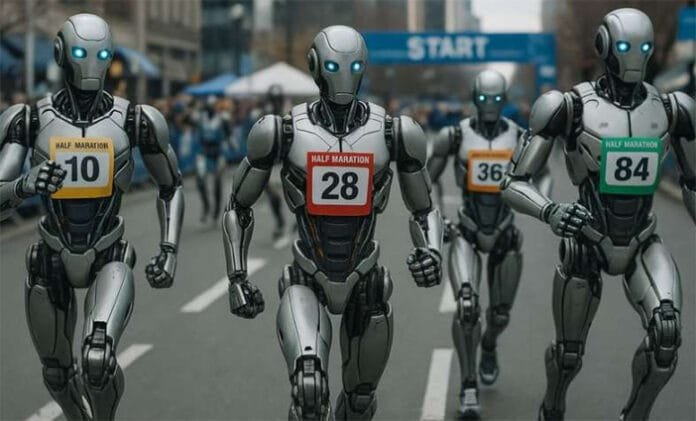Beijing Hosts Historic Half-Marathon Between Humans and Robots
INVC NEWS : Beijing witnessed a landmark event that captured the world’s attention — a half-marathon where 21 robots raced alongside human runners for a grueling 21 kilometers (13 miles). Held in the city’s southeastern Yizhuang district, home to China’s technology giants, the event was not merely a spectacle but a bold statement. China showcased its determination to dominate the global robotics industry, pushing the boundaries of innovation and endurance.
Leading Chinese companies such as DroidUp and Noetics Robotics fielded their cutting-edge robots, with participants ranging from 120 centimeters (3.9 feet) to 1.8 meters (5.9 feet) in height. This dynamic race symbolized more than just technological prowess; it demonstrated the real-world capabilities of Chinese robotics, aligning with the nation’s broader ambition to set new global standards.
China’s Robotic Supremacy: Surpassing Germany and Japan
In a striking shift on the global stage, China has officially surpassed Germany and Japan in terms of robot density — a critical metric in industrial automation. As of 2023, China deployed 470 robots per 10,000 employees, overtaking Germany’s 429 and Japan’s 419. This remarkable progress is the result of sustained investments, aggressive innovation strategies, and a relentless push towards technological self-reliance.
With only South Korea and Singapore maintaining a higher robot density, China’s focus is now firmly set on overtaking these remaining leaders. If current trends persist, analysts predict that China could claim the global top spot within the next few years.
Global Humanoid Robot Market: Poised for Explosive Growth
The global humanoid robot market, still in its nascent phase, is projected to experience unprecedented growth. Valued at $2.43 billion in 2023, the market is expected to skyrocket to $66 billion by 2032, according to industry forecasts.
Humanoid robots — designed to mimic the human body in appearance and function — are gaining traction across sectors ranging from healthcare and eldercare to manufacturing and service industries. Though still largely in development stages, the momentum is undeniable.
In parallel, India’s humanoid robot market stood at $42 million in 2023 and is forecasted to reach approximately $149.4 million by 2030, highlighting the wider global shift toward robotic integration across economies.
Industrial Robots: A Workforce Revolution on the Horizon
According to a Goldman Sachs report, the humanoid robot sector is poised to reach $38 billion by 2035. The financial giant projects that within the next five years, approximately 250,000 humanoid robots will be deployed specifically for industrial applications, performing tasks ranging from assembly-line work to complex logistical operations.
By 2035, it is anticipated that over one million robots will be purchased directly by consumers, ushering in a new era where robots become an integral part of daily life — from domestic chores to personalized services.
China’s Vision: Total Robotics Leadership
China’s recent marathon spectacle, while seemingly novel, is part of a broader, deeply strategic initiative. Robotics has been enshrined as a core pillar of China’s economic and technological roadmap, with government policies and private enterprises working in unison to accelerate advancements.
Beijing’s approach combines state-sponsored incentives, massive research and development grants, and fostering an environment where startups and established giants alike can innovate at lightning speed. With companies like Huawei, DJI, and Xiaomi also expanding into robotics, the ecosystem is primed for exponential growth.
Moreover, China’s investment extends beyond hardware. The country is also making significant strides in robotic AI software, sensor technology, machine learning, and autonomous navigation systems, ensuring its dominance is holistic and future-proof.
South Korea and Singapore: The Last Competitors
Despite China’s rapid ascent, South Korea and Singapore remain the two nations still ahead in robot density. South Korea, the current global leader, has long been renowned for its commitment to automation, particularly in automotive and electronics manufacturing. Singapore, leveraging its smart nation initiatives, has seamlessly integrated robotics into logistics, healthcare, and security sectors.
Yet, China’s momentum suggests that it is not a matter of if, but when, it will eclipse these nations. Experts predict that within the next decade, China could lead the world both in robot density and technological capability.
The Strategic Importance of Robot Density
Robot density — the number of robots per 10,000 workers — is more than just a statistic. It represents a country’s industrial sophistication, productivity potential, and readiness for the future economy. Nations with high robot density are better positioned to mitigate labor shortages, enhance manufacturing precision, and boost economic resilience.
For China, increasing robot density is aligned with national strategies like “Made in China 2025” and the 14th Five-Year Plan, aiming to transform the country into a global tech superpower.
















